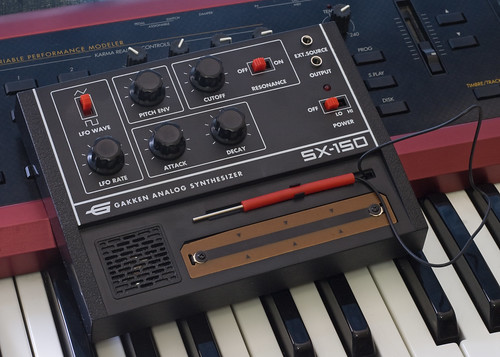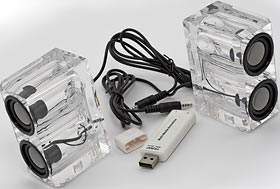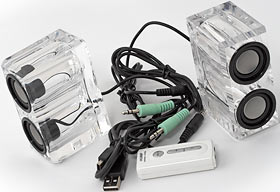I bought a Gakken SX-150. It's the first electronic musical instrument from their brilliant "Otona no Kagaku" line of "magazine kits", which all come in a funny box with a magazine attached to it that contains instructions for building whatever the thing is.
(Gakken also make the Cross Copter and Mechamo Centipede about which I have previously written.)
The instructions, like Gakken's Web sites, are always in Japanese, but this seldom poses much of a problem. Particularly not in the case of the SX-150, which is quite trivial to put together. As I write this, the Hobbylink Japan page for the SX-150 says "It requires both cement and painting to complete or use. 124 parts" is incorrect. You actually only have to screw the circuit board into the casing, screw down the contacts for the two ends of the ribbon controller and the stylus, and screw down the edges of the little speaker. And put four AAs in it. And cut out and attach the cardboard back panel, if you like.
(I found that Hobbylink Japan had it the cheapest, for Australian shoppers anyway, at about 4380 yen delivered, which is under $US50 as I write this. But it's also out of stock at the moment. The Make: store has it for a higher price, though, as do several other dealers.)
Herewith, a quick SX-150 FAQ.
Does it have to sound like a Stylophone?
No.
The SX-150 doesn't have what you'd call a huge palette of tonal variety - mainly pitch and resonance variations on a, yes, distinctly Stylophone-ish screech - but you can also coax a decent bass tone out of it, as well as various sweeps and bleeps of no use for melodies.
This discussion on monome.org mentions people not seeing the point of the SX-150 until they heard a "mid 90's acid track"; I concur.
Apparently, someone at Gakken said "Let's make a small device with which people will be able to approximately recreate the lead-synth line from Da Hool's "Meet Her At The Love Parade", and somebody else said "Well, it'll need at least a Resonance knob, then", and the SX-150 sort of grew from there.
(Their next product will presumably be the Europa-8, purpose-built to allow you to play the lead synth line from "Axel F".)
The tiny built-in speaker is of course not a bass-monster, but it's easy to plug the SX-150 into other speakers. Its "Output" socket is a fairly hot line-level, so can't drive full-sized headphones very loudly. (It'll probably be OK with little earbud headphones.) It should work fine with any guitar amplifier or effects pedal/unit, though, or with hi-fi gear and headphone amplifiers. I have already connected it to the stereo through an old cheesy digital reverb unit, with entertaining (for me, anyway) results.
Can you actually play a tune on it?
Yes. I was very pleasantly surprised by how musical this tinny little thing actually is.
The standard pitch control on the SX-150 is the prominent black resistance "ribbon" on the front, which you play with the little wired stylus. Left is bass, right is treble, and the total pitch range of the ribbon is a bit more than four octaves.
Some people have achieved tune-playing on an SX-150 by hacking an actual keyboard onto it, with keys connected to the stylus terminal that make contact with the stock ribbon controller at the appropriate points. But you don't need to do that. Even with the standard ribbon, someone with reasonable dexterity can play actual repeatable notes.
The ribbon makes the SX-150 a "fretless" instrument, like a violin or fretless bass. So you'll never actually hit exactly the same note twice. But the pitch-change-per-millimetre is constant - an octave is about 19mm, no matter where on the strip you're playing - and this makes the SX-150 much easier to play than many real fretless instruments. In all regular string instruments, the notes get closer and closer together as they get higher - you can see this effect in the spacing of the frets on fretted instruments.
So in this respect, the SX-150 is like the ondes Martenot or its younger, poorer cousin the Electro-Theremin, which can both make very theremin-y sounds (that's an Electro-Theremin in "Good Vibrations", for instance, not a proper theremin), but are operated by simply moving your hand a set distance for a set pitch change, no matter what pitch you're starting from.
(And then there are trombones, which I have yet to be persuaded do not produce entirely random tones.)
I don't know much about electronics. Can I still do interesting things with an SX-150 (besides just trying to play it)?
Yes. Adding actual new non-trivial features to the SX-150 isn't for beginners, but this thing is genuinely educational, in the very best way. It can teach you things about electronics, and about analogue synthesisers.
Some basic facts: The probe is negative, and the probe-to-strip voltage varies from about 1.6V at the high end of the strip to about 0.8V at the low end. The end-to-end resistance of the strip is about 50 kiloohms.
What this means is that when you connect the probe to the top end of the strip through a multimeter, as I did to get the above numbers, the SX-150 will play a very low note, as a tiny amount of current passes through the multimeter's voltage range.
Many similar tricks are possible. Hold the probe-end in one hand, for instance, lick a finger on the other hand and press it to the top of the strip, and you'll get a low-bass note. Sliding your finger down from there will get you lower and lower bass, far beyond the ability of the tiny speaker to reproduce.
Use a paper-clip as a second stylus, touching the lengthy bit of bare metal on the proper stylus to the paper-clip and then disconnecting it again, with the other end of both stylus and clip touching the ribbon, to create a yodelling effect!
Observe the small but noticeable change in pitch and noise when you hold the stylus close to the tip - so your skin touches the stylus metal - as opposed to holding only the plastic handle!
And the SX-150 is a very limited instrument, of course, of very little use for "real" music. But limitations focus you on what you can do, and this really is a bonsai analogue synthesiser to play with, not just a Stylophone.
Does the "EXT.SOURCE" socket actually do anything?
Yes, imaginary questioner, it does. How convenient that you just asked exactly the right question for me to be able to continue what I just wrote.
The EXT.SOURCE input is a simple example of what all the fuss is about with analogue synthesisers, and the modern software simulations thereof. If you plug a very "hot" signal into that input, it converts amplitude to pitch. Line-level isn't good enough (which is why many people seem to have concluded that it doesn't do anything at all), and most headphone sockets won't go loud enough either; Gakken made this input to interface with their little Theremin. If you've got a loud enough input, though - like a headphone amplifier, or a normal amp turned up only a little bit - there it is; the louder the input, the higher the tone from the SX-150.
This is not very useful, if you don't have the little Theremin. Actually, I think it's probably not terribly useful even if you do. But it helps you make the one great conceptual leap of the analogue synthesiser, especially the modular analogue synth that's a wall of separate "modules" connected together with a spaghetti of patch leads.
That conceptual leap is to realise that audio signals, when conveniently converted to electricity, can readily be transformed in this sort of way. If amplitude becomes pitch a "BOOM tish BOOM tish BOOM tish" drum line becomes "peep boop peep boop peep boop".
That's the whole point of the modular synth. It's all just voltages that different modules create or modify in different ways, and how and where those voltages become actual sounds is entirely up to you.
The SX-150 doesn't take you all the way back to Jean-Jacques and Delia, recording individual oscillator-noises on tape and then endlessly dubbing and splicing. But no mere human has the patience for that. It does, however, give you a real little insight into the dawn of the true synthesiser. So even if you have to pay $US75 for it, I reckon it's a pretty good deal.
UPDATE: Here's someone playing an SX-150.
(The reverb effect later in the clip is, of course, being created by outboard hardware.)
Here's one of many modified versions:


